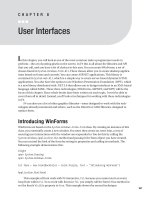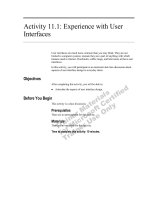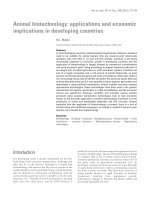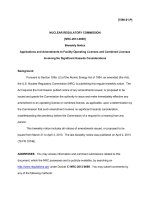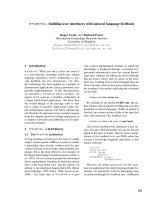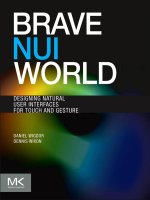multiple user interfaces cross-platform applications and context-aware interfaces
Bạn đang xem bản rút gọn của tài liệu. Xem và tải ngay bản đầy đủ của tài liệu tại đây (6.16 MB, 416 trang )
Multiple User Interfaces
Cross-Platform Applications and
Context-Aware Interfaces
Edited by
Ahmed Seffah and Homa Javahery
Concordia University, Department of Computer Science, Canada
Multiple User Interfaces
Multiple User Interfaces
Cross-Platform Applications and
Context-Aware Interfaces
Edited by
Ahmed Seffah and Homa Javahery
Concordia University, Department of Computer Science, Canada
Copyright 2004 John Wiley & Sons Ltd, The Atrium, Southern Gate, Chichester,
West Sussex PO19 8SQ, England
Telephone (+44) 1243 779777
Email (for orders and customer service enquiries):
Visit our Home Page on www.wileyeurope.com or www.wiley.com
All Rights Reserved. No part of this publication may be reproduced, stored in a retrieval system or
transmitted in any form or by any means, electronic, mechanical, photocopying, recording, scanning or
otherwise, except under the terms of the Copyright, Designs and Patents Act 1988 or under the terms of a
licence issued by the Copyright Licensing Agency Ltd, 90 Tottenham Court Road, London W1T 4LP, UK,
without the permission in writing of the Publisher. Requests to the Publisher should be addressed to the
Permissions Department, John Wiley & Sons Ltd, The Atrium, Southern Gate, Chichester, West Sussex PO19
8SQ, England, or emailed to , or faxed to (+44) 1243 770620.
This publication is designed to provide accurate and authoritative information in regard to the subject matter
covered. It is sold on the understanding that the Publisher is not engaged in rendering professional services. If
professional advice or other expert assistance is required, the services of a competent professional should be
sought.
Other Wiley Editorial Offices
John Wiley & Sons Inc., 111 River Street, Hoboken, NJ 07030, USA
Jossey-Bass, 989 Market Street, San Francisco, CA 94103-1741, USA
Wiley-VCH Verlag GmbH, Boschstr. 12, D-69469 Weinheim, Germany
John Wiley & Sons Australia Ltd, 33 Park Road, Milton, Queensland 4064, Australia
John Wiley & Sons (Asia) Pte Ltd, 2 Clementi Loop #02-01, Jin Xing Distripark, Singapore 129809
John Wiley & Sons Canada Ltd, 22 Worcester Road, Etobicoke, Ontario, Canada M9W 1L1
Wiley also publishes its books in a variety of electronic formats. Some content that appears
in print may not be available in electronic books.
Library of Congress Cataloging-in-Publication Data
Multiple user interfaces : cross-platform applications and context-aware interfaces / edited by
Ahmed Seffah & Homa Javahery.
p. cm.
Includes bibliographical references and index.
ISBN 0-470-85444-8
1. Computer interfaces. I. Seffah, Ahmed. II. Javahery, Homa.
TK7887.5.M86 2003
004.6 – dc22
2003057602
British Library Cataloguing in Publication Data
A catalogue record for this book is available from the British Library
ISBN 0-470-85444-8
Typeset in 10/12pt Times by Laserwords Private Limited, Chennai, India
Printed and bound in Great Britain by TJ International, Padstow, Cornwall
This book is printed on acid-free paper responsibly manufactured from sustainable forestry
in which at least two trees are planted for each one used for paper production.
Contents
Acknowledgements xv
About the Editors xvii
Contributors xix
PART I BASIC TERMINOLOGY, CONCEPTS, AND CHALLENGES 1
1 Executive Summary and Book Overview 3
Ahmed Seffah and Homa Javahery
1.1 Motivation 3
1.2 A Few Definitions 4
1.3 Challenges 5
1.4 Specific Objectives 5
1.5 Audience 6
1.6 Overview 6
References 9
2 Multiple User Interfaces: Cross-Platform Applications and
Context-Aware Interfaces 11
Ahmed Seffah and Homa Javahery
2.1 MUI: Characterization and Evolution 11
2.1.1 Interaction Styles 13
2.1.2 Fundamental Characteristics 15
2.1.3 Vertical versus Horizontal Usability 16
2.1.4 Related Work 16
2.2 Fertile Topics for Research Exploration 18
2.2.1 Context-Aware Development 18
2.2.2 Model-Based Development 20
vi CONTENTS
2.2.3 Pattern-Driven Development 22
2.2.4 Device-Independent Development 23
2.3 Concluding Remarks 24
Acknowledgements 25
References 25
PART II ADAPTATION AND CONTEXT-AWARE USER INTERFACES 27
3 A Reference Framework for the Development of Plastic User Interfaces 29
David Thevenin, Jo¨elle Coutaz, and Ga¨elle Calvary
3.1 Introduction 29
3.2 Terminology: Context of Use, Plastic UI and Multi-Target UI 30
3.2.1 Context of Use and Target 30
3.2.2 Multi-Target User Interfaces and Plastic User Interfaces 31
3.2.3 Terminology: Summary 32
3.3 The “Plastic UI Snowflake” 32
3.3.1 Target Sensitivity 33
3.3.2 Classes of Software Tools 33
3.3.3 Actors in Charge of Adaptation 34
3.3.4 Computation of Multi-Target and Plastic User Interfaces 35
3.3.5 User Interface Software Components 35
3.3.6 User Interface Migration 37
3.4 The Process Reference Framework for Multi-Target and Plastic UIs 37
3.4.1 General Description 38
3.4.2 The Process Reference Framework in the Design Phase 39
3.4.3 Instantiations of the Process Reference Framework 41
3.5 ARTStudio: An Application of the Process Reference Framework 43
3.5.1 The EDF Home Heating Control System 43
3.5.2 ARTStudio 43
3.6 Conclusion 49
Acknowledgement 49
References 49
4 Temporal Aspects of Multi-Platform Interaction 53
David England and Min Du
4.1 Introduction 53
4.2 Temporal Contexts of Multiple Platforms 55
4.2.1 Fitts’ Law and the Control:Display Ratio 55
4.2.2 Computation Speed of the Platform 56
4.2.3 Support for Task Switching on Platforms 56
4.3 Modelling Temporal Contexts 57
4.3.1 Action Selection Pattern 58
4.3.2 Progress Monitoring Pattern 59
CONTENTS vii
4.3.3 Task Management Pattern 61
4.3.4 Platform Interaction Pattern 62
4.4 The Temporal Constraint Engine 63
4.5 Discussion 64
4.6 Conclusions 65
References 65
A. The PUAN Notation 66
5 The PALIO Framework for Adaptive Information Services 69
Constantine Stephanidis, Alexandros Paramythis, Vasilios Zarikas,
and Anthony Savidis
5.1 Introduction 69
5.2 The PALIO System Architecture 71
5.2.1 Overview 71
5.2.2 The PALIO Adaptation Infrastructure 75
5.3 PALIO as an Adaptive Hypermedia System 76
5.3.1 Adaptation Determinants 77
5.3.2 Decisions on the Basis of Adaptation Determinants 78
5.3.3 Adaptation Actions 80
5.4 PALIO in the Context of MUI 83
5.4.1 PA L I O as a We b UI 83
5.4.2 A Brief Example 88
5.5 Summary and On-Going Work 89
Acknowledgements 90
References 90
Footnotes 91
PART III DEVELOPMENT TECHNOLOGY AND LANGUAGES 93
6 Building Multi-Platform User Interfaces with UIML 95
Mir Farooq Ali, Manuel A. P´erez-Qui˜nones, and Marc Abrams
6.1 Introduction 95
6.2 Terminology 97
6.3 Related Work 98
6.4 UIML 100
6.4.1 Language Overview 101
6.4.2 The
<interface> Component 101
6.4.3 The
<peers> Component 102
6.4.4 A Sample UI 102
6.5 A Framework for Multi-Platform UI Development 104
6.5.1 Task Model 105
6.5.2 Generic Description of Device Families 106
6.5.3 Abstract to Concrete Transformations 109
viii CONTENTS
6.6 Transformation-Based UI Development Environment 111
6.6.1 TIDE Version 1 112
6.6.2 Goals for TIDE 2 112
6.7 Conclusions 115
Acknowledgements 116
References 116
7 XIML: A Multiple User Interface Representation Framework
for Industry 119
Angel Puerta and Jacob Eisenstein
7.1 Introduction 119
7.1.1 Special Challenges for MUI Solutions for Industry 120
7.1.2 Foundation Technologies 121
7.1.3 Summary of Chapter 121
7.2 The XIML Representation Framework 121
7.2.1 Target Computing Model 122
7.2.2 XIML Requirements 123
7.2.3 Structure and Organization of XIML 124
7.2.4 Validation Exercises 127
7.3 An XIML Pilot Application 133
7.3.1 MANNA: The Map Annotation Assistant 134
7.3.2 The MANNA Abstract XIML Components 136
7.3.3 XIML-Based Middleware for MANNA 139
7.4 Discussion 144
7.4.1 The XIML Roadmap 144
7.4.2 Related Work 145
7.4.3 Summary of Findings 146
Acknowledgements 146
References 146
8 AUIT: Adaptable User Interface Technology, with Extended Java
Server Pages 149
John Grundy and Wenjing Zou
8.1 Introduction 149
8.2 Case Study: A Collaborative Job Management System 151
8.3 Related Work 152
8.4 Our Approach 154
8.5 Design and Implementation 156
8.6 Job Management System Examples 161
8.7 Experiences 164
8.8 Summary 166
References 166
CONTENTS ix
PART IV MODEL-BASED DEVELOPMENT 169
9 Adaptive Task Modelling: From Formal Models to XML
Representations 171
Peter Forbrig, Anke Dittmar, and Andreas M¨uller
9.1 Introduction 171
9.2 Model-Based Software Development 172
9.2.1 Models Used in the Design Process 172
9.2.2 Task Modelling 172
9.2.3 New Challenges for Modelling 175
9.3 Adaptive Specification Techniques 176
9.3.1 Adapted Task Models 177
9.3.2 Specification of Device Features by XML 179
9.4 Example of an Electronic Shop 181
9.4.1 The Task Model of E-Shopping 181
9.4.2 The Generation of Specific User Interfaces 183
9.5 Conclusions 191
References 191
10 Multi-Model and Multi-Level Development of User Interfaces 193
Jean Vanderdonckt, Elizabeth Furtado, Jo˜ao Jos´e Vasco Furtado,
Quentin Limbourg, Wilker Bezerra Silva, Daniel William Tavares Rodrigues,
and Leandro da Silva Taddeo
10.1 Introduction 193
10.2 Related Work 194
10.3 Definition of Model 195
10.4 Conceptual Level 198
10.4.1 Definition 198
10.4.2 Case Study 199
10.5 Logical Level 201
10.5.1 Definition 201
10.5.2 Case Study 202
10.6 Physical Level 205
10.6.1 Definition 205
10.6.2 Case Study 205
10.7 Summary of the Development Process 210
10.8 Conclusion 213
Acknowledgements 214
References 215
11 Supporting Interactions with Multiple Platforms Through User
and Task Models 217
Luisa Marucci, Fabio Patern`o, and Carmen Santoro
11.1 Introduction 217
x CONTENTS
11.2 An Illustrative Scenario 219
11.3 General Description of the Approach 221
11.4 Role of the Task Model in Design 223
11.4.1 From the Task Model to the Abstract User Interface 225
11.4.2 The Language for Abstract User Interfaces 226
11.4.3 From the Abstract User Interface to its Implementation 228
11.5 Relations between Task Model and User Model 228
11.6 The User Model 229
11.7 Adaptive Rules 232
11.7.1 Navigation as a Function of Task Frequency 232
11.7.2 Navigation as a Function of Task Performance 234
11.7.3 Modification of Presentation 235
11.7.4 Modification of Content Presentation 235
11.8 Conclusions 237
Acknowledgements 237
References 238
PART V ARCHITECTURES, PATTERNS, AND
DEVELOPMENT TOOLKITS 239
12 Migrating User Interfaces Across Platforms Using HCI Patterns 241
Homa Javahery, Ahmed Seffah, Daniel Engelberg, and Daniel Sinnig
12.1 Introduction 241
12.2 A Brief Overview of HCI Patterns 243
12.3 Redesigning User Interfaces with Pattern Mapping 245
12.3.1 The Effect of Screen Size on Redesign 245
12.3.2 Pattern-based Redesign: A Case Study with Navigation
Patterns 247
12.3.3 Architecture Size as an Added Variable in Redesign 248
12.4 Research Directions for the Use of Patterns in Reengineering User
Interfaces 254
12.4.1 Pattern-Assisted Reengineering 255
12.4.2 Comparing Reengineering to Redesign 256
12.5 Conclusion and Future Investigations 257
Acknowledgements 259
References 259
13 Support for the Adapting Applications and Interfaces to Context 261
Anind K. Dey and Gregory D. Abowd
13.1 Introduction 261
13.2 Why Context is Difficult to Use and Why Support is Needed for it 264
13.2.1 Separation of Concerns 264
13.2.2 Context Interpretation 265
CONTENTS xi
13.2.3 Transparent, Distributed Communications 265
13.2.4 Constant Availability of Context Acquisition 266
13.2.5 Context Storage and History 266
13.2.6 Resource Discovery 266
13.3 Basic Component-Based Architecture and the Conference Assistant
Application 267
13.3.1 Context Widgets 268
13.3.2 Context Aggregators 268
13.3.3 Context Interpreters 269
13.3.4 Services 269
13.3.5 Discoverers 270
13.3.6 Conference Assistant Application 270
13.3.7 Summary 276
13.4 Situation Support and the CybreMinder Application 276
13.4.1 Implementation of the Situation Abstraction 277
13.4.2 CybreMinder: A Complex Example that Uses the Situation
Abstraction 278
13.4.3 Summary 283
13.5 Fusion Support and the In/Out Board Application 284
13.5.1 The Architecture of the Location Service 285
13.5.2 Representing Location 286
13.5.3 Details on Positioning Systems 287
13.5.4 Fusion and Aggregation of Location 289
13.5.5 Accessing, Interpreting and Handling Location Data Within
an Application 289
13.5.6 Sample Application Development 291
13.5.7 Summary 292
13.6 Conclusions 293
Acknowledgements 294
References 294
14 A Run-time Infrastructure to Support the Construction of Distributed,
Multi-User, Multi-Device Interactive Applications 297
Simon Lock and Harry Brignull
14.1 Introduction 297
14.2 MUI Interaction Scenario 298
14.3 Requirements for Infrastructure 299
14.4 Existing Approaches 301
14.5 Design of Infrastructure and Development Framework 303
14.5.1 Design of Interaction Metaphor 305
14.5.2 Bubble Glosses 307
14.6 Implementation of Infrastructure and Development Framework 310
14.7 Operation of the Infrastructure 311
14.7.1 Dynamic Device Service Registration 311
xii CONTENTS
14.7.2 Dynamic Device Service Selection 311
14.7.3 Application Service Linkage 312
14.7.4 Bubble Synchronisation 313
14.8 Infrastructure Utilisation 314
14.9 Application Usage Scenarios 316
14.10 Discussion 320
14.11 Conclusions 321
References 322
PART VI EVALUATION AND SOCIAL IMPACTS 325
15 Assessing Usability across Multiple User Interfaces 327
Gustav
¨
Oquist, Mikael Goldstein and Didier Chincholle
15.1 Introduction 327
15.2 Multiple User Interfaces: Multiple Contexts
of Use 328
15.3 Multiple Contexts of Use: Multiple Factors
of Usability 330
15.3.1 Portability 330
15.3.2 Attentiveness 331
15.3.3 Manageability 333
15.3.4 Learnability 334
15.3.5 Indexical Factors of Usability for Different Contexts of Use 335
15.4 Assessing Usability of Mobile Interfaces 336
15.4.1 Mobile Input Interfaces 337
15.4.2 Mobile Output Interfaces 341
15.5 Discussion 346
15.6 Conclusions 347
References 348
16 Iterative Design and Evaluation of Multiple Interfaces for a Complex
Commercial Word Processor 351
Joanna McGrenere
16.1 Introduction 351
16.2 Design Solutions to Complex Software 353
16.3 Study One 355
16.3.1 Methodology 355
16.3.2 Selected Results 356
16.4 Pilot Study 359
16.4.1 Implementation 360
16.4.2 Objectives and Methodology 361
16.4.3 Selected Results 362
CONTENTS xiii
16.5 Study Two 363
16.5.1 Methodology 365
16.5.2 Selected Results 366
16.6 Summary and Conclusions 369
Acknowledgements 371
References 371
Footnotes 372
17 Inter-Usability of Multi-Device Systems – A Conceptual Framework 373
Charles Denis and Laurent Karsenty
17.1 Introduction 373
17.2 Inter-Usability: A Conceptual Framework 374
17.2.1 Principal Processes Involved in Transitions between Devices 374
17.2.2 Requirements for Knowledge Continuity 376
17.2.3 Requirements for Task Continuity 379
17.3 Design Principles for Inter-Usability 380
17.3.1 Inter-Device Consistency 381
17.3.2 Transparency 382
17.3.3 Adaptability 383
17.4 Conclusion 384
Acknowledgements 384
References 384
Subject Index 387
Acknowledgements
The help of many people made this book possible, and we are grateful to all of them. We
thank our editor Birgit Gruber, at John Wiley & Sons Ltd., who guided us throughout
this project.
Daniel Engelberg and Jonathan Benn were indispensable for the editing process, and
we thank them for their help in editing various chapters. Daniel Sinnig patiently helped
with revising various chapters. Rozita Naghshin, our digital art expert, was a great source
of help for advice on image layout and creation. To all the members of the HCSE (Human-
Centered Software Engineering) Group, we thank you for participating in the discussion
and brainstorming of this project.
We thank FCAR (Le Fonds qu
´
eb
´
ecois de la recherche sur la nature et les technologies),
NSERC (National Sciences and Engineering Council of Canada), and the Faculty of
Engineering, Concordia Research Chair programs, for their financial support.
We are grateful to all the reviewers of this book. We were lucky enough to have a
wide spectrum of international reviewers, who patiently reviewed all chapters and gave
us crucial feedback. We thank John Grundy from the University of Auckland, who gave
us sound advice and feedback for a number of chapters.
Above all, we thank the contributors of this book. Without them, this book would not
have been possible. We thank them for patiently modifying chapters, rewriting passages,
and putting up with our requests. We acknowledge all of them for their efforts in making
this book a success.
Ahmed Seffah Homa Javahery
About the Editors
Ahmed Seffah is a professor in the department of Computer Science at Concordia Uni-
versity. He is director of the Human-Centered Software Engineering Group and the
co-founder of the Concordia Software Usability and Empirical Studies Lab. He holds
a PhD in software engineering from the Ecole Centrale de Lyon (France). His research
interests are at the crossroads between software engineering and Human-Computer Inter-
action (HCI), including usability measurement, user interface design, empirical studies
on developer experiences with CASE tools, human-centered software engineering, and
patterns as a vehicle for integrating HCI knowledge in software engineering practices.
Dr. Seffah is the vice-chair of the IFIP working group on user-centered design method-
ologies. During the last 10 years, he has been involved in different projects in North
America and Europe.
Homa Javahery is a researcher and project manager with the Human-Centered Soft-
ware Engineering Group, including the Usability and Empirical Studies Lab, in the
department of Computer Science at Concordia University. She holds a Master’s degree
in Computer Science from Concordia University, and a Bachelor of Science degree from
McGill University. She is combining different design approaches from human sciences
and engineering disciplines to develop a pattern-oriented framework for designing a large
variety of interfaces. She has been involved in different collaborative projects at the
INRIA Research Institute in Nancy, France and the Daimler-Chrysler Research Institute
in Ulm, Germany.
Contributors
Gregory D. Abowd
College of Computing
Georgia Institute of Technology
Atlanta, Georgia 30332-0280
USA
Marc Abrams
Harmonia, Inc.
PO Box 11282
Blacksburg, VA 24062
USA
Harry Brignull
University of Sussex
Room 5A3, Interact Lab
School of Cognitive
and Computing Sciences
Falmer, Brighton BN1 9QH
UK
+44 (0) 1273 877221
Ga
¨
elle Calvary
IIHM Group, CLIPS-IMAG Lab
BP 53, 385 rue de la Bibliotheque
38041 Grenoble Cedex 9
France
+33476514854
Didier Chincholle
Ericsson Research ERA/TVU/U
Torshamnsgatan 23, 164 80 Kista
Sweden
+46 8 585 303 76
Jo
¨
elle Coutaz
IIHM Group, CLIPS-IMAG Lab
BP 53, 385 rue de la Bibliotheque
38041 Grenoble Cedex 9
France
+33476514854
Charles Denis
INTUILAB
Prologue 1, La Pyr
´
en
´
eenne,
BP 27/01, 31312 Lab
`
ege Cedex
France
Anind K. Dey
Senior Researcher, Intel Research
2150 Shattuck Ave, Suite 1300
Berkeley, CA 94704
USA
+1-510-495-3012
xx CONTRIBUTORS
Anke Dittmar
University of Rostock
Department of Computer Science
Albert-Einstein-Str. 21
D-18051 Rostock
Germany
Min Du
Liverpool John Moores University
School of Computing
and Mathematical Sciences
Byrom St, Liverpool
L3 3AF UK
+44 (0) 151 231 2271
Jacob Eisenstein
CEO – RedWhale Software
277 Town & Country Village Palo Alto
CA 94303
USA
+1 650 321-3425
Daniel Engelberg
CGI Group Inc.
1130 Sherbrooke West, 7th floor
Montreal, Quebec H3A 2M8
Canada
+1 514-281-7000, local 5820
David England
Liverpool John Moores University
School of Computing
and Mathematical Sciences
Byrom St, Liverpool
L3 3AF UK
+44 (0) 151 231 2271
Mir Farooq Ali
Virginia Technology Institute
Department of Computer Science (0106)
660 McBryde Hall
Blacksburg, VA 24061
USA
1(540) 231 1927
Peter Forbrig
University of Rostock
Department of Computer Science
Albert-Einstein-Str. 21
D-18051 Rostock
Germany
Elizabeth Furtado
Universidade de Fortaleza
NATI – C
´
elula EAD
Washington Soares, 1321
Bairo Edson Queiroz
Fortaleza (Cear
´
a), BR-60455770
Brazil
Jo
˜
ao Jos
´
e Vasco Furtado
Universidade de Fortaleza
NATI – C
´
elula EAD
Washington Soares, 1321
Bairo Edson Queiroz
Fortaleza (Cear
´
a), BR-60455770
Brazil
Mikael Goldstein
Ericsson Research ERA/TVU/U
Torshamnsgatan 23
164 80 Kista
Sweden
+46 8 757 3679
John Grundy
University of Auckland
Department of Computer Science
Private Bag 92019
Auckland
CONTRIBUTORS xxi
New Zealand
+64-9-3737-599 ext. 8761
Homa Javahery
Department of Computer Science
Faculty of Engineering
and Computer Science
1455 de Maisonneuve Blvd West
Montreal, Quebec H3G 1M8
Canada
h
+1 514-848-3024
Laurent Karsenty
INTUILAB
Prologue 1, La Pyr
´
en
´
eenne,
BP 27/01, 31312 Lab
`
ege Cedex
France
Quentin Limbourg
Universit
´
e catholique de Louvain (UCL)
Information System Unit (ISYS-BCHI)
Institut d’Administration et de Gestion
(IAG)
Place des Doyens, 1
B-1348 Louvain-la-Neuve
Belgium
+32-10.47.85.25
Simon Lock
Lancaster University
Computing Department
Lancaster LA1 4YR
UK
+44-1524-592795
Luisa Marucci
ISTI-CNR
Via G. Moruzzi 1
56100 Pisa
Italy
+39 050 3153066
Joanna McGrenere
University of British Columbia
Department of Computer Science
201–2366 Main Mall
Vancouver, BC V6J 2E2
Canada
604-827-5201
Andreas M
¨
uller
University of Rostock
Department of Computer Science
Albert-Einstein-Str. 21
D-18051 Rostock
Germany
Gustav
¨
Oquist
Bollhusgr
¨
and 7
113 31 Stockholm
Sweden
+46 8 739 417 783
Alexandros Paramythis
Foundation for Research and
Technology – Hellas
Institute of Computer Science
Science and Technology Park of Crete
Heraklion, Crete
GR – 71110 Greece
+30-810-391741
Fabio Patern
`
o
ISTI-CNR
Via G. Moruzzi 1
56100 Pisa
Italy
+39 050 3153066
xxii CONTRIBUTORS
Manuel P
´
erez-Qui
˜
nones
Virginia Technology Institute
Department of Computer Science (0106)
660 McBryde Hall
Blacksburg, VA 24061
USA
1(540) 231 2646
Angel R. Puerta
CEO – RedWhale Software
277 Town & Country Village Palo Alto
CA 94303
USA
+1 650 321-3425
Carmen Santoro
ISTI-CNR
Via G. Moruzzi 1
56100 Pisa
Italy
+39 050 3153066
Anthony Savidis
Foundation for Research
and Technology – Hellas
Institute of Computer Science
Science and Technology Park of Crete
Heraklion, Crete,
GR – 71110 Greece
+30-810-391741
Ahmed Seffah
Concordia University
Department of Computer Science
Faculty of Engineering
and Computer Science
1455 de Maisonneuve Blvd West
Montreal, Quebec H3G 1M8
Canada
+1 514-848-3024
Wilker Bezerra Silva
Universidade de Fortaleza
NATI – C
´
elula EAD
Washington Soares, 1321
Bairo Edson Queiroz
Fortaleza (Cear
´
a), BR-60455770
Brazil
Daniel Sinnig
Concordia University
Department of Computer Science
Faculty of Engineering
and Computer Science
1455 de Maisonneuve Blvd West
Montreal, Quebec H3G 1M8
Canada
+1 514-848-3024
Constantine Stephanidis
Foundation for Research
and Technology – Hellas
Institute of Computer Science
Science and Technology Park of
Crete
Heraklion, Crete, GR – 71110
Greece
+30-810-391741
Leandro da Silva Taddeo
Universidade de Fortaleza
NATI – C
´
elula EAD
Washington Soares, 1321
Bairo Edson Queiroz
Fortaleza (Cear
´
a), BR-60455770
Brazil
Daniel William Tavares Rodrigues
Universidade de Fortaleza
NATI – C
´
elula EAD
Washington Soares, 1321
Bairo Edson Queiroz
Fortaleza (Cear
´
a), BR-60455770
